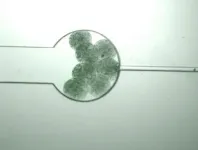(Press-News.org) It is generally agreed that sperms "swim" by beating or rotating their soft tails. However, a research team led by scientists from City University of Hong Kong (CityU) has discovered that ray sperms move by rotating both the tail and the head. The team further investigated the motion pattern and demonstrated it with a robot. Their study has expanded the knowledge on the microorganisms' motion and provided inspiration for robot engineering design.
The research is co-led by Dr Shen Yajing, Associate Professor from CityU's Department of Biomedical Engineering (BME), and Dr Shi Jiahai, Assistant Professor of the Department of Biomedical Sciences (BMS). Their findings have been published in the science journal Proceedings of the National Academy of Sciences of the United States of America (PNAS), titled "Self-adaptive and efficient propulsion of Ray sperms at different viscosities enabled by heterogeneous dual helixes".
Surprising discovery
Their research disclosed a new and peculiar motion mode of ray sperms, which they call the "Heterogeneous Dual Helixes (HDH) model". "This was actually an accidental discovery," said Dr Shi who has been focusing on developing different bio-therapies.
It all started with the team's another research of developing artificial insemination techniques for farming cartilaginous fishes, including sharks and rays, whose skeleton is wholly or largely composed of cartilage. "Cartilaginous fishes can be used as a 'factory' to produce antibodies against diseases, including COVID-19. So we wanted to develop artificial insemination techniques to farm them for high-value aquaculture," he said.
During that process, the team was greatly surprised when they first observed the unique structure and swimming motion of ray sperms under the microscope. They discovered that the ray sperm's head is in a long helical structure rather than being round, and it rotates along with the tail when swimming.
The team further investigated its propulsion mechanism, especially the exact role of the head in motion. They found that ray sperms consist of heterogeneous helical sections: a rigid spiral head and a soft tail, which are connected by a "midpiece" that provides energy for rotational motion. The ray sperm's head is not only a "container" of the genetic materials but also facilitates the propulsion together with the soft tail.
High Energy Efficiency of the HDH propulsion
To understand the motion mode more, the team analysed a large quantity of swimming data and observed the sperms' inner structure at the nanoscale. Since both the head and tail of the ray sperm rotated in the same direction with various rotational speeds and amplitudes when swimming, the team named this as the heterogeneous dual helixes (HDH) propulsion.
According to their statistical analysis, the head contributed about 31% of the total propulsive force, which is the first recorded head propulsion in all know sperms. Because of the head's contribution, the motion efficiency of the ray sperm is higher than other species like the sterlet and bull, which are only driven by the tail.
"Such an untraditional way of propulsion not only provides ray sperms with high adaptability to a wide range of viscous environments, but also leads to superior motion ability, and efficiency," explained Dr Shen, whose research focus is robotics as well as micro/nano manipulation and control.
High Environmental Adaptability
Environmental adaptability is crucial in natural selection. The head and tail of the ray sperms can adjust their motion and contribution to propulsion according to the environmental viscosity and swim at different speeds for forwarding motion. Hence, ray sperms can move in various environments with a wide range of viscosities, demonstrating high environmental adaptability.
The team also found that ray sperms have a unique bi-directional swimming ability, meaning that they can swim not only in a forward direction but also in a backward direction. Such an ability provides advantages to sperms in nature, especially when they encounter obstacles. And other sperms with spherical or rod-shaped head cannot achieve bidirectional motion.
Thanks to the HDH model, the spiral head of ray sperms has an active turning ability. As both the head and tail contribute to the propulsion, the angle between them will produce a lateral force on the body, enabling the ray sperm to turn, showing high flexibility in its motion.
Bio-inspired robot demonstrates the HDH model
The peculiar HDH model showed extensive features in motility and efficiency and inspired the team in designing microrobots. The bio-inspired robot, also with a rigid spiral head and a soft tail, demonstrated similar superiorities over conventional ones in terms of adaptability and efficiency under the same power input. It could move skillfully in an environment with liquid, even when the viscosity changed.
Such abilities can provide insights for designing swimming robot for challenging engineering tasks and biomedical applications inside the human body with complex fluidic environments, like inside blood vessels.
"We believed that understanding this unique propulsion would revolutionise the knowledge in microorganisms' motion, which would facilitate the understanding of natural fertilisation and provide inspiration for the design of bio-inspired robots under viscous conditions," concluded Dr Shen.
INFORMATION:
Dr Shen and Dr Shi are the corresponding authors of the paper. Dr Wang Panbing from Dr Shen's group, and Dr M. A. R. Al Azad from Dr Shi's group, are the first authors. Other co-authors are Mr Yang Xiong, a PhD student from BME at CityU, and researchers from the Ocean Park Corporation Hong Kong.
The research received funding support from the National Science Foundation of China, Hong Kong Health and Medical Research Fund, Research Grants Council of Hong Kong, Shenzhen Science and Technology Innovation Fund, Sanming Project of Medicine in Shenzhen, and Tung Biomedical Sciences Center.
https://www.cityu.edu.hk/research/stories/2021/06/09/discovery-ray-sperms-unique-swimming-motion-and-demonstration-bio-inspired-robot
An electrode coating just one molecule thick can significantly enhance the performance of an organic photovoltaic cell, KAUST researchers have found. The coating outperforms the leading material currently used for this task and may pave the way for improvements in other devices that rely on organic molecules, such as light-emitting diodes and photodetectors.
Unlike the most common photovoltaic cells that use crystalline silicon to harvest light, organic photovoltaic cells (OPVs) rely on a light-absorbing layer of carbon-based molecules. Although OPVs cannot yet rival the performance of silicon cells, they could be easier and cheaper to manufacture at a very large scale using ...
The type of material present under glaciers has a big impact on how fast they slide towards the ocean. Scientists face a challenging task to acquire data of this under-ice landscape, let alone how to represent it accurately in models of future sea-level rise.
"Choosing the wrong equations for the under-ice landscape can have the same effect on the predicted contribution to sea-level rise as a warming of several degrees", says Henning Åkesson, who led a new published study on Petermann Glacier in Greenland.
Glaciers and ice sheets around the world currently lose more than 700,000 Olympic swimming pools of water every day. Glaciers form by the transformation of snow into ice, which is later melted by ...
With the start of the United Nations' Decade on Ecosystem Restoration, which runs through 2030, a tremendous amount of money and effort will be put into re-growing forests, making over-exploited farmland productive, and reviving damaged marine environments. This is a good, and vital, initiative. Without quick action to clean up the fallout of humanity's scorched-earth economic systems, goals on hunger, biodiversity and climate will be unattainable.
But in examining restoration projects already underway across the globe, a group of scientists has found that restoration action is at risk of failure if it doesn't make ...
Palaeoclimatologists study climate of the geological past. Using an innovative technique, new research by an international research team led by Niels de Winter (VUB-AMGC & Utrecht University) shows for the first time that dinosaurs had to deal with greater seasonal differences than previously thought.
De Winter: "We used to think that when the climate warmed like it did in the Cretaceous period, the time of the dinosaurs, the difference between the seasons would decrease, much like the present-day tropics experience less temperature difference between ...
Inaccessible workplaces, normative departmental cultures and 'ableist' academic systems have all contributed to the continued underrepresentation and exclusion of disabled researchers in the Geosciences, according to an article published today (Thursday 8 June) in Nature Geosciences.
The article argues that changes to both working spaces and attitudes are urgently needed if institutions are to attract, safeguard and retain people with disabilities.
Anya Lawrence, a disabled early career researcher in the University of Birmingham's School of Geography, Earth and Environmental Science and author of the piece says:
"Disabled geoscientists like myself face barrier after barrier on a daily ...
People who smoke, suffer from high blood pressure, obesity, or diabetes are not only at greater risk of suffering a stroke, heart attack, or dementia. For them, the risk of being affected by depressive mood or depression also increases. The more risk factors a person has, the more likely this is. Until now, however, it was unclear whether this probability also depends on their age. Earlier studies had already shown for other diseases such as dementia or stroke that a combination of several risk factors leads to a more frequent onset of the disease between the ages of 40 and 65 than in old age. Until now, however, it was unclear whether this also applies to depression.
Researchers ...
MORGANTOWN, W. Va.-- Joining a club that sparks a new interest, playing a new intramural sport or finding a new group of friends may be just as indicative of a college freshman's loss of self-control as drinking or drug use, according to new research at West Virginia University.
Self-control--the ability to exercise personal restraint, inhibit impulsivity and make purposeful decisions--in that first year partly depends on a student's willingness to try new things, including things adults would call "good."
That's a new finding, according to Kristin Moilanen, associate professor of child development and family studies. The study, "Predictors of initial status and change in self-control during the college transition," observed 569 first year ...
DURHAM, N.C. - Biomedical engineers at Duke University have demonstrated that a class of interwoven composite materials called semi-interpenetrating polymer networks (sIPNs) can be produced by living cells. The approach could make these versatile materials more biologically compatible for biomedical applications such as time-delayed drug delivery systems.
The research appears online on June 8 in the journal Nature Communications.
The concept of sIPNs has been around for more than 100 years and has been used in automotive parts, medical devices, molding compounds and engineering plastics. The general idea is for one or more polymers to assemble around another polymer scaffold in such a way that they become interlocked. Even though ...
Humans expect that AI is Benevolent and trustworthy. A new study reveals that at the same time humans are unwilling to cooperate and compromise with machines. They even exploit them.
Picture yourself driving on a narrow road in the near future when suddenly another car emerges from a bend ahead. It is a self-driving car with no passengers inside. Will you push forth and assert your right of way, or give way to let it pass? At present, most of us behave kindly in such situations involving oth-er humans. Will we show that same kindness towards autonomous vehicles?
Using methods ...
As COVID-19 restrictions ease nationwide and more people host indoor gatherings, investing in a high efficiency particulate air (HEPA) purifier might not be a bad idea, says a University of Cincinnati College of Medicine researcher.
Several published studies evaluating aerosols and submicron particles similar in size to the SARS-CoV-2 virion have shown that portable HEPA purifiers are able to significantly reduce airborne COVID-19 particles, says Ahmad Sedaghat, MD, PhD, director of the UC Division of Rhinology, Allergy and Anterior Skull Base Surgery.
Sedaghat identified the medical literature showing published studies on the effectiveness ...





